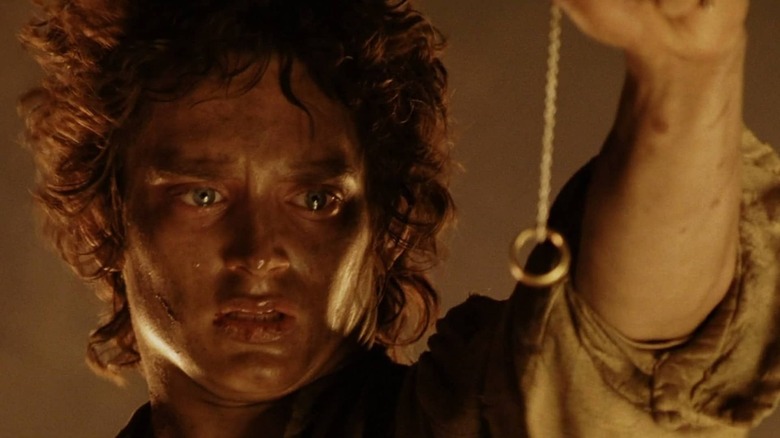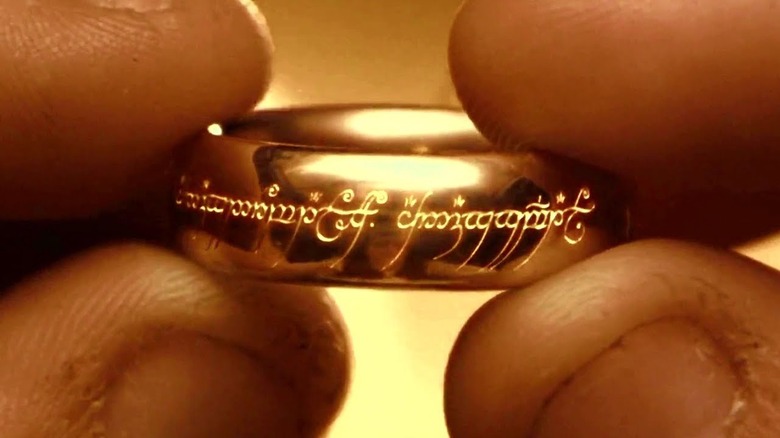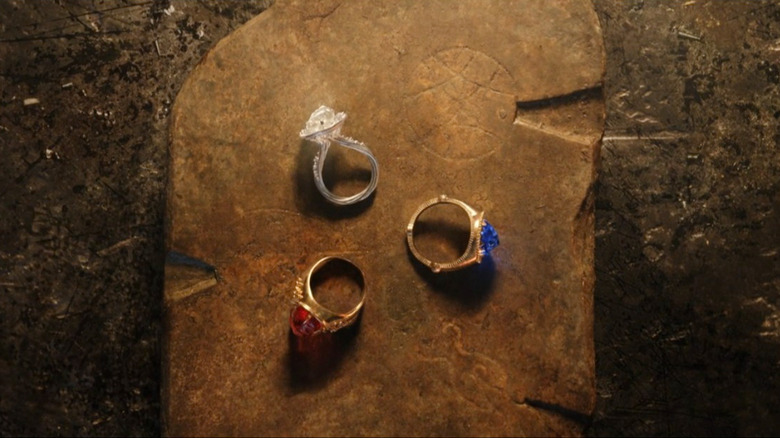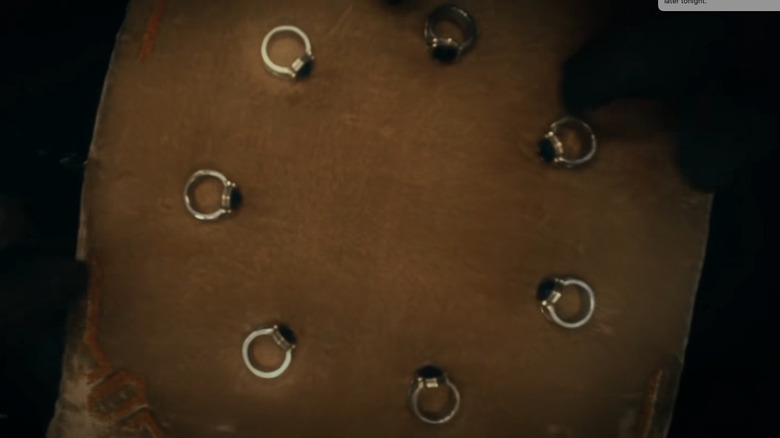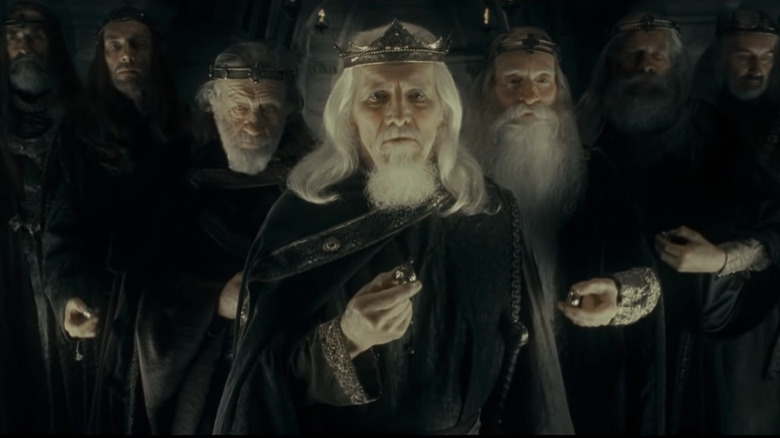Where Are The Rings Of Power During LOTR?
There aren't a ton of links between "The Lord of the Rings" and "The Rings of Power." It's hard to connect narratives several thousand years apart, even when you're in the same world and half of your characters are immortal. But the connections are there if you look for them. Characters like Galadriel, Sauron, and Elrond show up in both stories. There are also familiar places, like Khazad-dûm and Mordor.
One of the biggest throughlines of them all is the titular Rings of Power. These overpowered trinkets manage to show up in the titles for both stories and heavily influence the Second and Third ages of Middle-earth history in which "Rings of Power" and "The Lord of the Rings" are set, respectively.
Technically, there are a lot of magical rings made in Middle-earth. In "The Fellowship of the Ring" book, Gandalf explains that "In Eregion long ago many Elven-rings were made, magic rings as you call them, and they were, of course, of various kinds: some more potent and some less." The Wizard adds that while the lesser rings were still important, "the Great Rings, the Rings of Power, they were perilous."
There are 20 "Great Rings" in total. That's the group listed in J.R.R. Tolkien's famous "Ringverse" — the whole Nine for Mortal Men, Seven for the Dwarf-lords, Three for the Elven Kings, and One for the Dark Lord bit of poetry. Add them all up, and you get 20 superpowered spiritual weapons. We're seeing these come into existence in "The Rings of Power," where the show has uncanonically introduced them out of order, with the Three Elven Rings forged in Season 1 and the others to come. The question is, where is all of this circular jewelry by the time we get to "The Lord of the Rings"?
The One Ring is in the center of the narrative
The easiest Ring of Power to track is the One Ring itself. This is the "big one" that Sauron forges to dominate all the others. In the centuries leading up to "The Lord of the Rings," the One Ring lies at the bottom of the Great River until Sméagol — later Gollum – finds it and takes it with him into his subterranean mountain dwelling. It's there that the Ring officially shows up in "The Hobbit" when Bilbo finds it right before his riddle competition with Gollum. From there, Bilbo uses the Ring throughout his ensuing adventures, never guessing how important it actually is.
When J.R.R. Tolkien sat down to write a sequel to "The Hobbit," he settled on the Ring as the main connecting point between both stories, and he meant it. The One Ring shows up repeatedly throughout the story, starting with Bilbo's reluctant bequeathal of the item to Frodo in the first chapter. From there, the Ring is at the center of everything.
Gandalf watches and helps Frodo specifically because he has the Ring. The quest begins because the One Ring needs to be kept safe from the hunting Nazgûl ... and then morphs into a journey devoted to destroying the Ring by throwing it into the Cracks of Doom. Once Frodo gets the Ring, he keeps it for nearly the entire story — with two brief recorded exceptions. The first is when Sam takes temporary ownership of the tainted treasure when Frodo is captured by Orcs on their way into Mordor. The second is when Gollum bites the Ring off of Frodo's finger at Mount Doom. After that, the Ring is destroyed in the fiery depths of the volcanic mountain, and it comes to an end along with the story.
The Three Elven Rings are hard to spot ... but they're right there
In "The Fellowship of the Ring," Elrond explains that "The Three were not made by Sauron, nor did he ever touch them. But of them it is not permitted to speak. So much only in this hour of doubt I may now say. They are not idle."
While they remain hidden, it's possible to trace all three rings with a little detective work. Let's start with the easiest one. Galadriel keeps Nenya, the Ring of Water, and while she doesn't reveal it on purpose, Frodo does see it on her hand when he visits Lothlorien. The other two go through multiple owners before "The Lord of the Rings." By that time, Elrond has Vilya, the Ring of Air, and Gandalf is in possession of Narya, the Ring of Fire.
While they aren't sullied by Sauron directly, the Elven Rings are still under the influence of the One Ring. When that is destroyed, the Three leave Middle-earth with their owners. In fact, they all take off in the same ship together at the end of "The Return of the King." J.R.R. Tolkien summarized this in the Appendices to that book, saying, "Frodo and Bilbo depart over Sea with the Three Keepers."
"The Silmarillion" elaborates that after the War of the Ring, "it was made plain that the power of the Three Rings also was ended." Shortly after this, it adds, "And latest of all the Keepers of the Three Rings rode to the Sea, and Master Elrond took there the ship that Círdan had made ready." That ship sets sail for the Blessed Realm in the west (basically a sort of heaven on earth for the Elves), and that's the last we hear of the Three.
Sauron has the Dwarf rings...the ones that aren't Dragon food
Seven of the Rings of Power end up with the Dwarves. There's a debate about whether Sauron gives all seven as gifts meant to enslave their recipients or if one of them comes from the Elves. Either way, they all end up tainted by the One Ring. However, this doesn't do the Dark Lord much good.
"The Return of the King" book explains, "For the Dwarves had proved untameable by this means. The only power over them that the Rings wielded was to inflame their hearts with a greed of gold and precious things, so that if they lacked them all other good things seemed profitless, and they were filled with wrath and desire for vengeance on all who deprived them."
This amplification of desire turns each Dwarven ring into the center of a vast treasure horde. As with all glittering concentrations of wealth, these attract unwelcome visitors. By the time of "The Lord of the Rings," Gandalf sums up where all Seven Dwarf rings are in a single, loaded sentence by saying, "Seven the Dwarf-kings possessed, but three he has recovered, and the others the dragons have consumed."
In the space of 16 terrifying words, Gandalf implies that seven ring-bearing Dwarven kings (and presumably their kingdoms and treasures) have perished in the flames of dragon-fire and war. We never hear what happened to them after this. However, Gandalf does add, "It has been said that dragon-fire could melt and consume the Rings of Power," implying that four of the Dwarf rings are melted. As far as the other three, the "he" mentioned is Sauron, and we never hear what he does with them. Perhaps they end up like the Nine Rings for Mortal Men ...
The Nine Rings for Mortal Men remain busy during LOTR
The Nine Rings of Power that end up with mortal Men are very active during the "Lord of the Rings" story. Sauron originally gives these to a group of mortal humans, that "The Silmarillion" describes thusly, "Those who used the Nine Rings became mighty in their day, kings, sorcerers, and warriors of old. They obtained glory and great wealth, yet it turned to their undoing." A bit later, it adds that one by one, "they fell under the thraldom of the ring that they bore and under the domination of the One, which was Sauron's."
These nine Men become the Nazgûl, the Ringwraiths, the Black Riders — call them what you like, they're some of the most terrifying villains in the entire story. By that point, they are so enslaved to Sauron's will that their Nine Rings of Power remain tethered to the Dark Lord, even when he doesn't have the One Ring. They hunt Frodo in "The Fellowship of the Ring" and lead Sauron's armies in "The Return of the King."
We witness the end of the Nine Rings right after the destruction of the One Ring. As Mordor is wracked by spiritually wrought, ring-induced convulsions, the Nazgûl are likewise caught up in the fiery chaos, meeting their end along with the Rings.
